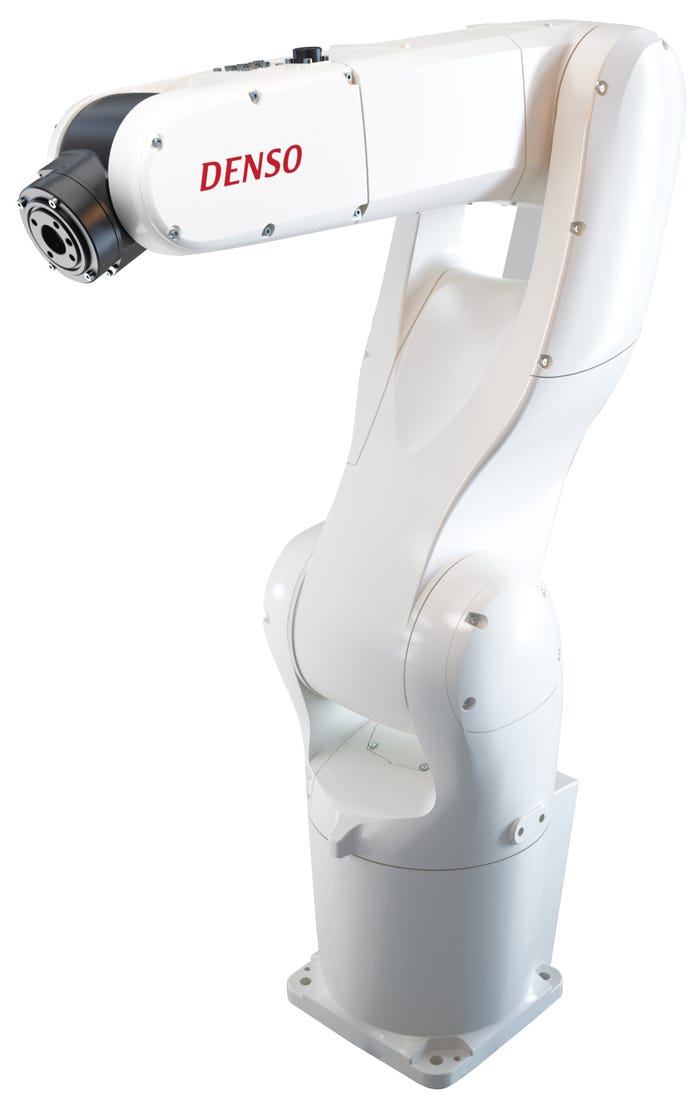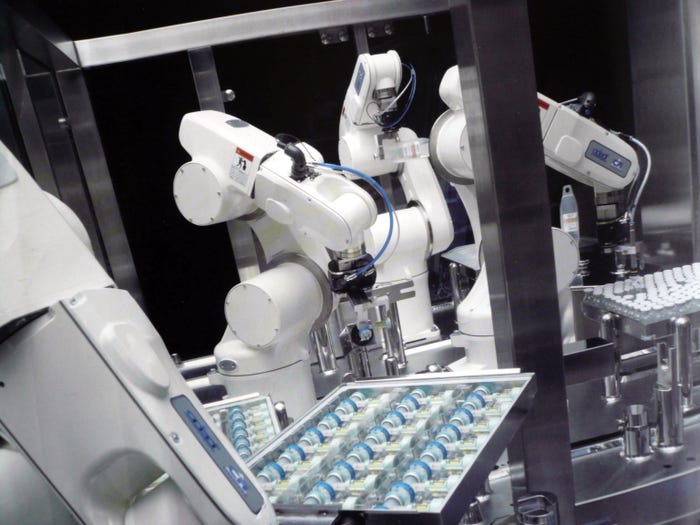April 13, 2013
|
Available with workspaces ranging from 500 to 900 mm, Denso's VS-series robots are used for assembling small medical parts. |
In contrast to hard automation technologies, robots are flexible systems that can be retooled and reprogrammed.
Over the last few years, robotics has made increasing inroads into medical device assembly operations. Previously dominated by automation systems dedicated to performing specific functions, the medical device manufacturing industry is finding that flexible, redeployable robots can accelerate the production process, reduce costs, and facilitate the assembly of small, hard-to-handle components.
Because the medical device industry must satisfy stringent regulatory requirements, manufacturers have not been able to shorten product life cycles as aggressively as have manufacturers of consumer goods. Nevertheless, with the increasing use of flexible automation, the medical device sector is attempting to accelerate tooling and process changeovers in order to cut costs and accelerate time to market. As a result, robots have found their way into an array of medical device manufacturing operations, including assembly, dispensing, inspection, machine tending, material handling, and packaging.
Small-Parts Handling
Robots can handle medical device assembly operations in a unique way, remarks Chris Blanchette, manager of national distribution sales for Fanuc Robotics (Rochester Hills, MI). Because modern parts are small, pliable, and not always consistent from a tolerance perspective, they can be difficult to locate and manipulate using hard tooling.
Fanuc's M-1iA robot used in medical device assembly applications can handle such difficult parts, according to Blanchette. Featuring a 0.5-kg payload specification--with the stipulation that the gripper and the part it picks up must weigh less than 0.5 kg--the system can assemble small parts with a repeatability of ±0.02-mm and can perform assembly processes down to the 10- or 20-µm level. Every robot has an allowable workspace, Blanchette adds. "If you have a large robot that can handle work in a workspace environment of 6 × 6 ft, it's probably not a good robot for small-part assembly. In contrast, the M-1iA has a workspace of approximately 8 in. Thus, it's designed to work with the very small parts that are typical in the medical device industry."
Denso Robotics (Long Beach, CA) is another supplier of medical device-compatible robots that are designed for assembling small, difficult-to-handle parts. Capable of achieving repeatability down to approximately 20 µm, its HS SCARA-series, VS-series, and articulated VS-series robots feature workspaces ranging in size from 350 to 900 mm, making them suitable for most size-constrained medical device assembly operations.
Robots such as these have increased throughputs and reduced costs associated with the assembly of parts that are hard to handle using manual or even hard-automation processes, Blanchette notes. "I think we're going to see more robotics in this industry, and I think that they're going to help manufacturers to invent medical devices that previously weren't manufacturable because hard automation methods weren't capable of handling the small parts used today in an array of medical devices."
Promoting Flexible Manufacturing
Robots also offer the advantage of being able to adapt to different part types using intelligence-based features such as vision and integrated force-sensing capability, Blanchette says. For example, if a manufacturer needs to insert a tube into a pin, the robot can feel its way into that assembly process. In contrast, adapting to new assembly processes is difficult for hard-automation processes because routines are typically fixed and precise. "Thus, the flexibility inherent in robotics--especially in conjunction with intelligent features built into them--has allowed medical device companies to manufacture products a lot easier, more cost-effectively, and more reliably," Blanchette adds.
|
Adept's six-axis articulated robots deliver precision, traceability, and flexibility in the assembly of medical devices. |
Rush LaSelle, director of sales and marketing worldwide for Adept Technology Inc. (Pleasanton, CA) agrees that robotics has gained a crucial toehold in the medical device industry because they promote flexible manufacturing practices. Offering Cartesian, SCARA, articulated, and delta/parallel robots, Adept--like Fanuc and Denso--offers a range of robots that rely on sensory input such as vision. Coupled with integrated vision capability, Adept's technologies incorporate precision motion control, sensor-based interfaces, and application software.
The combination of these features results in flexible automation technologies that can perform diverse multitasking operations. "For lower-volume applications, robots are capable of multitasking and automating a variety of functions within a given workspace," LaSelle comments. "The number of operations a robot can perform is constrained only by cycle-time considerations, physical space, and the nature of the tooling--whether a common tool or a defined set of tools can handle the various operations."
For example, a single assembly station might be equipped with a robot featuring several tools. One tool might pick up a substrate and place it into a fixture. Another tool might apply adhesive onto the part's mating surface, while a third tool might place the mating part onto the assembly and then move the assembly to another station or a conveyor. "In this example, the robot might wield all the tools," LaSelle notes. "Alternatively, it might be required to use a quick-change device to shift from a pick-and-place gripper to an adhesive-dispensing tool."
Based on intelligent control, robotics enables manufacturers to achieve a level of flexibility that would be unthinkable using hard automation. "Let's say a manufacturer wants to introduce a new syringe," Blanchette says. "Since hard automation uses mechanical stops to lock assembly positions into place, if you change the size of your syringe, all of the hard tooling--the stops and other components--would have to be remanufactured." A robot's vision system, on the other hand, can identify parts of different sizes, enabling the unit to adapt its position to the new specifications without having to modify the existing tooling.
Denso sales manager Peter Cavallo echoes the sentiment that robots' flexibility simplifies automation routines. "The nice thing about a robot is that all of the kinematics and all the details are worked out for the user," he remarks. "So, when you have a robot, you don't have to teach it or create all the programs to make it move. If you want the robot to move on a curved path, you set just a few points, and it figures out all the details for you."
This functionality adds a level of versatility to production processes that enables manufacturers to reduce fixturing or preconditioning costs associated with locating and picking products. It also facilitates more-rapid changeovers between batches or production runs and expands companies' inspection capabilities.
One of the keys to this improved functionality is optimized reprogramming methods. Using simulation tools, for example, manufacturers can reprogram Fanuc's robots offline in order to incorporate new products or processes into an assembly operation, according to Blanchette. After the robot has been programmed, the new assembly data can then be downloaded via Ethernet into the robot and introduced into production. As a result, assembly operations can be accelerated, potentially improving manufacturers' return on investment.
Achieving Traceability
Most medical device manufacturers are required to comply with 21 CFR Part 11 guidelines, which define how electronic records and electronic signatures are validated and how a system's traceability is certified. Once it has been validated, a system cannot be changed without being validated again. Consequently, among the most beneficial features of robots is their ability to ensure traceability.
"Previously, both the robot and its programmable logic controller (PLC) required separate validation," LaSelle states. "Now, using Adept's ePLC robot-programming capability, the robot can be validated simply by validating the PLC." The company's compact controls architecture is another means for achieving production traceability. Regardless of whether products are tracked using bar codes, RFID, or vision, Adept's robots, according to LaSelle, provide the tools and connectivity required to communicate with work management and supervisory control and data-acquisition systems.
Traceability and verifiability are among the key advantages of robotic technology, Cavallo concurs. "In the robotics area, once you've automated something, you have complete traceability and validation," he says. "Most devices must undergo validation, especially if they're going to be used inside the body. Robots and automation make it easier--and less costly--for medical device manufacturers to validate their products for the FDA."
You May Also Like




